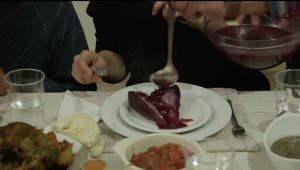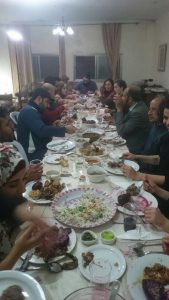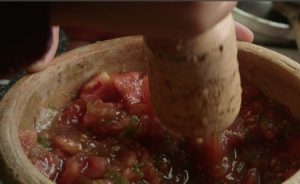Family Dinners Project Part 3 of 6
Food has always been a representation of class, time, and power. It creates a unique atmosphere conducive to encounter. Sharing food sets the table with aspects of hospitality, distribution, exchange, familiarity, and pleasure. A shared meal can become a space for reflection on socio-political realities, attitudes, fashions of the time, and even the suppressed elements of history.
In a research project that documents Palestinian food practices, initiated by artist Mirna Bamieh and supported by the Public Program of A.M. Qattan Foundation, “Family Dinners” is a series of five dinners that were served over a two-month period to groups of food enthusiasts. This article is the third in a series that describes these dinners.
Gaza was present in its full glory at the second Family Dinners event. Titled On the Table of Abu Heiba’s Family, its menu, put together by Shaima Hamad and the Abu Heiba family, told a specific and personal story of Palestine: that of constant uprooting.
Abu Heiba’s family originally comes from the village Abu Kbeir, near Jaffa. In 1948, they were exiled to the Khan Yunis refugee camp in Gaza, where Abu Sami grew up in the Yaffawi neighborhood (after the Nakba, each neighborhood at the refugee camp was named after the area where the majority of its inhabitants came from). Um Sami’s family is related to Abu Heiba, but hers was exiled from Salameh, near Jaffa, to Balata Refugee Camp. After Um Sami and Abu Sami were married, she moved to Khan Yunis and spent ten years learning from her mother-in-law how to cook the Gazan dishes that were very different from the ones she knew from her Nabulsi upbringing. When Abu Sami took up studies at Birzeit University, the family moved to Birzeit and bought land in Abu Shkheidmin, a nearby village where they still live today. Gaza remains inaccessible, and food constitutes the strongest means through which the parents can keep their children connected to the city they love.
Shaima, a close friend of the Abu Heiba family, always found their shared table of food fascinating. She loved to explore the various techniques of Gazan cooking, the special spices, and the array of new dishes that she had never before tasted. Because Shaima can experience Gaza only through the food of the Abu Heiba family, she felt inspired to prepare a menu with Um Sami that all the family helped to cook.
Each dish holds a memory for this family, reflecting their migration from Jaffa to Nablus, then Gaza, and eventually Abu Shkheidmin. For example, kaftet al-sredeh, minced fish kafta, reminds Abu Sami of how the abundance of fish in Gaza once made people mince it to replace the minced meat in this traditional dish. Unfortunately, Israel now imposes rigid regulations on fishermen regarding where they are allowed to fish, making it impossible for them to make a living and affecting food provision for all Gazans.
The menu of “On The Table of Abu Heiba” consisted of Gazan fattet zaghaleel, a celebration dish in Gazan households that features roasted pigeons that were raised by the family in their garden, stuffed with smoked wheat, served on a bed of bread soaked in pigeon stock, and covered with a layer of rice, all sprinkled with daggit toma wa laimoun, a dressing made of hot chili, lemon, and garlic. Stuffed carrots with tamarind sauce were served on the side, as was rummaniyya, a dish that reached Gaza with the refugees from Jaffa and that has become a staple in the Gaza kitchen even though it is almost forgotten in Yaffa now. It consists of brown lentils cooked with eggplant, sour pomegranate molasses, and the red tahini that is yet another Gazan specialty. Palestinians rarely serve only one dish for their guests, so the table also included sfiha yafawiyyeh, a thin dough stuffed with ground meat and pine nuts and rolled into swirls, and sumagiyya, a quintessential dish in Gaza. It is usually prepared in large batches for Eid al-Fitr, which celebrates the end of Ramadan, and consists of a meat stew cooked with chard, sumac, and a sauce prepared from red tahini. Zibdiyet gambari, shrimp served in a clay pot, and dagga gazawiyya, a spicy tomato salad, the most basic and frequently served salad in Gaza, rounded up the main course.
The meal ended on a delicious note, with knafeh arabiyya, the special knafeh of Gaza that is made from coarse semolina, olive oil or ghee, cinnamon, and nutmeg, covered with a mix of nuts and drenched in sugar syrup after baking.
This elaborate menu precipitated a flow of memories and reflections among the twenty invited guests who came from various areas in Palestine to share their passion for food and storytelling.





